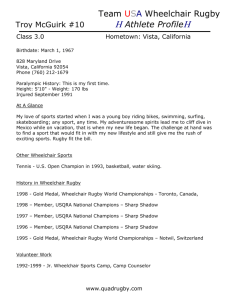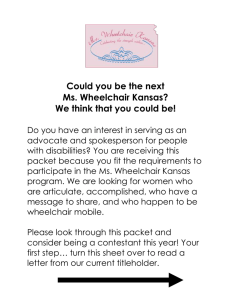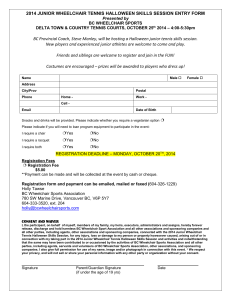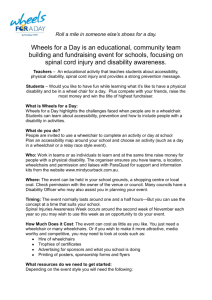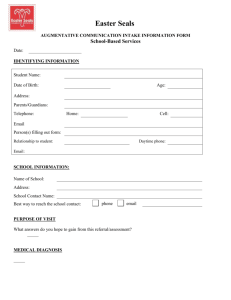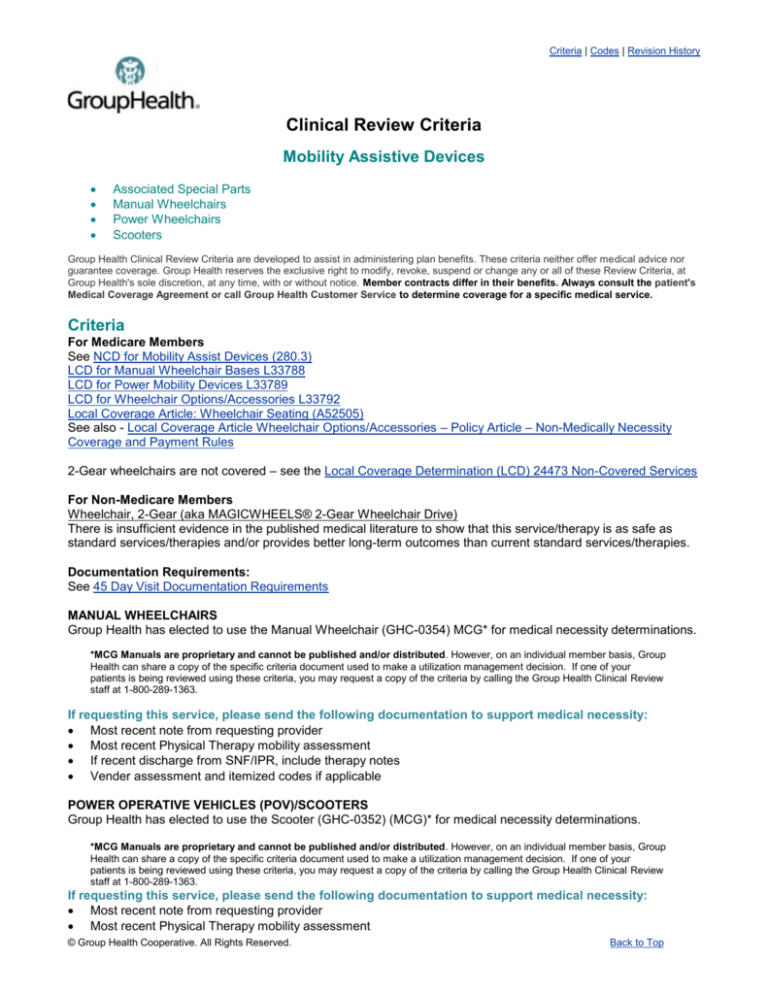
Criteria | Codes | Revision History
Clinical Review Criteria
Mobility Assistive Devices
Associated Special Parts
Manual Wheelchairs
Power Wheelchairs
Scooters
Group Health Clinical Review Criteria are developed to assist in administering plan benefits. These criteria neither offer medical advice nor
guarantee coverage. Group Health reserves the exclusive right to modify, revoke, suspend or change any or all of these Review Criteria, at
Group Health's sole discretion, at any time, with or without notice. Member contracts differ in their benefits. Always consult the patient's
Medical Coverage Agreement or call Group Health Customer Service to determine coverage for a specific medical service.
Criteria
For Medicare Members
See NCD for Mobility Assist Devices (280.3)
LCD for Manual Wheelchair Bases L33788
LCD for Power Mobility Devices L33789
LCD for Wheelchair Options/Accessories L33792
Local Coverage Article: Wheelchair Seating (A52505)
See also - Local Coverage Article Wheelchair Options/Accessories – Policy Article – Non-Medically Necessity
Coverage and Payment Rules
2-Gear wheelchairs are not covered – see the Local Coverage Determination (LCD) 24473 Non-Covered Services
For Non-Medicare Members
Wheelchair, 2-Gear (aka MAGICWHEELS® 2-Gear Wheelchair Drive)
There is insufficient evidence in the published medical literature to show that this service/therapy is as safe as
standard services/therapies and/or provides better long-term outcomes than current standard services/therapies.
Documentation Requirements:
See 45 Day Visit Documentation Requirements
MANUAL WHEELCHAIRS
Group Health has elected to use the Manual Wheelchair (GHC-0354) MCG* for medical necessity determinations.
*MCG Manuals are proprietary and cannot be published and/or distributed. However, on an individual member basis, Group
Health can share a copy of the specific criteria document used to make a utilization management decision. If one of your
patients is being reviewed using these criteria, you may request a copy of the criteria by calling the Group Health Clinical Review
staff at 1-800-289-1363.
If requesting this service, please send the following documentation to support medical necessity:
Most recent note from requesting provider
Most recent Physical Therapy mobility assessment
If recent discharge from SNF/IPR, include therapy notes
Vender assessment and itemized codes if applicable
POWER OPERATIVE VEHICLES (POV)/SCOOTERS
Group Health has elected to use the Scooter (GHC-0352) (MCG)* for medical necessity determinations.
*MCG Manuals are proprietary and cannot be published and/or distributed. However, on an individual member basis, Group
Health can share a copy of the specific criteria document used to make a utilization management decision. If one of your
patients is being reviewed using these criteria, you may request a copy of the criteria by calling the Group Health Clinical Review
staff at 1-800-289-1363.
If requesting this service, please send the following documentation to support medical necessity:
Most recent note from requesting provider
Most recent Physical Therapy mobility assessment
© Group Health Cooperative. All Rights Reserved.
Back to Top
Criteria | Codes | Revision History
If recent discharge from SNF/IPR, include therapy notes
Vender assessment and itemized codes if applicable
POWER WHEELCHAIR
1) Mobility Assistive Device (MAE) is reasonable and necessary for patients who have a personal mobility deficit
sufficient to impair their performance of Mobility-Related Activities of Daily Living (MRADL) such as toileting,
feeding, dressing, grooming, and bathing in customary areas in the home and coverage is considered when
the following has been applied:
a) The patient has a mobility limitation that significantly impairs his/her ability to participate in one or more
MRADLs in the home. A mobility limitation is one that:
i) Prevents the patient from accomplishing the MRADLs entirely, or,
ii) Places the patient at reasonably determined heightened risk of morbidity or mortality secondary to the
attempts to participate in MRADLs, or,
iii) Prevents the patient from completing the MRADLs within a reasonable time frame.
2) These other limitations can be ameliorated or compensated sufficiently such that the additional provision of
MAE will be reasonably expected to significantly improve the patient’s ability to perform or obtain assistance to
participate in MRADLs in the home.
a) A caregiver**, for example a family member, may be compensatory, if consistently available in the
patient's home and willing and able to safely operate and transfer the patient to and from the wheelchair
and to transport the patient using the wheelchair. The caregiver’s need to use a wheelchair to assist the
patient in the MRADLs is to be considered in this determination.
b) The amelioration or compensation requires the patient's compliance with treatment, for example
medications or therapy, substantive non-compliance, whether willing or involuntary. This can be
justification for denial of wheelchair coverage if it results in the patient continuing to have a significant
limitation. It may be determined that partial compliance results in adequate amelioration or compensation
for the appropriate use of MAE.
3) The patient or caregiver demonstrates the capability and the willingness to consistently operate the MAE
safely.
a) Safety considerations include personal risk to the patient as well as risk to others. The determination of
safety may need to occur several times during the process as the consideration focuses on a specific
device.
b) A history of unsafe behavior in other venues may be considered.
4) If a manual wheelchair or POV does not meet the mobility needs of the patient, and all of the following
features provided by a power wheelchair are needed to allow the patient to participate in one or more
MRADLs,
a) The pertinent features of a power wheelchair compared to a POV are typically controlled by a joystick or
alternative input device, lower seat height for slide transfers, and the ability to accommodate a variety of
seating needs.
b) The type of wheelchair and options provided should be appropriate for the degree of the patient’s
functional impairments.
c) The patient's home should provide adequate access, maneuvering space and surfaces for the operation
of a power wheelchair.
d) Assess the patient’s ability to safely use a power wheelchair.
e) The patient has had a face to face evaluation by the prescribing physician within the past 45 days which
assesses his/her mobility status, and the need for the power wheelchair.
**Note: If the patient is unable to use a power wheelchair, and if there is a caregiver who is available, willing, and
able to provide assistance, a manual wheelchair is appropriate. A caregiver’s inability to operate a manual
wheelchair can be considered in covering a power wheelchair so that the caregiver can assist the patient.
Home Assessment:
Coverage for the use of an electric wheelchair is determined solely for the needs within the home.
An on-site evaluation of the member’s home is necessary to verify that the member can adequately maneuver the
device that is provided considering the physical layout, doorway width, doorway thresholds, and surfaces. There
must be a written report of this evaluation available upon request.
Associated Special Parts:
The options/accessories are necessary for the patient to perform one or more of the following activities:
1) Function in the home.
2) Perform instrumental activities of daily living.
© Group Health Cooperative. All Rights Reserved.
Back to Top
Criteria | Codes | Revision History
An option/accessory that is beneficial primarily in allowing the patient to perform leisure or recreational activities is
non-covered.
Anti-rollback device (E0974)
Arm of Chair
Fully reclining back (E1226)
Has one or more:
Elevating Leg Rests (E0990,
K0046, K0047, K0053,
K0195)
Mechanically linked leg
elevation feature (E1009)
Power leg elevation feature
(E1010)
Hook-on headrest extension
Non-standard seat frame
(E2201-E2204, E2340-E2343)
Electronic Interface (E2351)
Swingaway, retractable, or
removable hardware (E1028)
Tilt-in-space seat
Power tilt seating system
(E1002)
Power reclining seat system
(E1003-E1005)
Power tilt and reclining seat
system (E1006-E1008)
The following are not covered
because they are not primarily
medical in nature
E1399, K0108
The patient propels himself/herself and needs the device because of ramps.
Adjustable arm height option (E0973, K0017, K0018, K0020) is covered if the
patient requires an arm height that is different than that available using
nonadjustable arms and the patient spends at least 2 hours per day in the
wheelchair.
An arm trough (E2209) is covered if patient has quadriplegia, hemiplegia, or
uncontrolled arm movements.
Quadriplegia
Fixed hip angle
Trunk or lower extremity casts/braces that require the reclining back feature
for positioning
Excess extensor tone of the trunk muscles and/or
The need to rest in a recumbent position two or more times during the day
and transfer between wheelchair and bed is very difficult
The patient has a musculoskeletal condition or the presence of a cast or
brace which prevents 90 degree flexion at the knee or
The patient has significant edema of the lower extremities that requires
having an elevated leg rest or
The patient meets criteria for and has a reclining back on the wheelchair
Meet criteria for elevating leg rest
And is receiving a covered power seating system
Has weak neck muscles and needs headrest for support OR
Meets criteria for and has reclining back on wheelchair
A nonstandard seat width and/or depth is covered only if the patient's
dimensions justify the need.
An electronic interface to allow a speech generating device to be operated by
the power wheelchair control interface is covered if the patient has a
covered speech generating device.
Needed to move the component out of the way so the patient can perform a
slide transfer AND
The sole reason is not to allow the patient to move close to desks or other
surfaces
Has documented weak upper extremity strength or a disease that will lead to
weak upper extremities. AND
Is at risk for skin break down because of inability to reposition body in chair
to relieve pressure areas.
Power seat elevation feature (E2300)
Power standing feature (E2301)
Attendant control (E2331)
Electrical connection devices (E2310 or E2311) with the sole function of
connection for a power seat elevation or power stand feature.
Electrical interface used to control lights or other electrical devices
Any part that is requested using either of these miscellaneous codes is
subject to review for medical necessity.
The following information was used in the development of this document and is provided as background only. It is not
to be used as coverage criteria. Please only refer to the criteria listed above for coverage determinations.
Background
In 2000, almost 1.7 million people in the United States used wheelchairs due to a disability. Of these, 1.5 million
people used a manual wheelchair (Kaye et al., 2000). Manual wheelchairs require extensive use of individuals’
upper limbs for mobility, transfer and other daily functional activities. This repetitive weight-bearing use of the arms
© Group Health Cooperative. All Rights Reserved.
Back to Top
Criteria | Codes | Revision History
and shoulders may cause upper-extremity problems, and reports of shoulder pain are common. In a recent survey
of individuals with thoracic spinal cord injuries, 40% of respondents reported current shoulder pain associated with
wheelchair use (Alm et al. 2008).
One way to address shoulder pain in manual wheelchair users is with stretching and strengthening exercises.
Several small trials have tested specific exercise programs and found statistically significant reduction in shoulder
pain (Nawoczenski et al., 2006; Curtis et al., 1999).
Another option, for individuals who want to continue using manual wheelchairs, is to reduce the force put on the
upper extremities by modifying the wheelchair. One modification is the addition of battery-powered wheels that can
be fitted to standard manual wheelchairs. These wheels add a motorized boost, or “torque multiplier” allowing the
user to go further with the same amount of force. A disadvantage of the battery-powered wheels is that the
currently available products are heavy. For example, the Alber E-Motion weighs 53 pounds, excluding the
wheelchair (Frankmobility.com). Newer, lighter products are being developed. The Quickie Xtend power assist
product weights 38 pounds (Quickie-wheelchairs.com). Another potential disadvantage of power-assisted wheels
is that the batteries need to be recharged, sometimes frequently, which can be disruptive to daily activities.
A different modification to the manual wheelchair is to use the 2-gear wheelchair drive produced by MagicWheels,
Inc. (Seattle, WA). The wheelchair drive adapts to most standard wheelchairs and does not include batteries or
motors. By sliding a switch, the user can change from a conventional 1:1 gear ratio to a 2:1 ratio. The added
weight is lighter than the battery-powered assist products. Depending on options, the additional weight per pair of
wheels varies from 8.2-10.5 pounds. The gear shifting is designed to reduce upper body stress and assist the user
to navigate ramps, hills and uneven terrain. Newer models include an automatic hill holding feature preventing the
wheelchair from sliding backwards between pulls while going uphill, and a downhill assisted braking feature.
MagicWheels was founded in 1996 by several partners. The University of Washington, where initial product
development research took place, owns stock in MagicWheels as part of a patent licensing agreement.
Evidence and Source Documents
Wheelchair, 2-Gear (aka MAGICWHEELS® 2-Gear Wheelchair Drive)
Medical Technology Assessment Committee (MTAC)
Wheelchair, 2-Gear (aka MAGICWHEELS® 2-Gear Wheelchair Drive)
BACKGROUND
In 2000, almost 1.7 million people in the United States used wheelchairs due to a disability. Of these, 1.5 million
people used a manual wheelchair (Kaye et al., 2000). Manual wheelchairs require extensive use of individuals’
upper limbs for mobility, transfer and other daily functional activities. This repetitive weight-bearing use of the arms
and shoulders may cause upper-extremity problems, and reports of shoulder pain are common. In a recent survey
of individuals with thoracic spinal cord injuries, 40% of respondents reported current shoulder pain associated with
wheelchair use (Alm et al. 2008). One way to address shoulder pain in manual wheelchair users is with stretching
and strengthening exercises. Several small trials have tested specific exercise programs and found statistically
significant reduction in shoulder pain (Nawoczenski et al., 2006; Curtis et al., 1999). Another option, for individuals
who want to continue using manual wheelchairs, is to reduce the force put on the upper extremities by modifying
the wheelchair. One modification is the addition of battery powered wheels that can be fitted to standard manual
wheelchairs. These wheels add a motorized boost, or “torque multiplier” allowing the user to go further with the
same amount of force. A disadvantage of the battery-powered wheels is that the currently available products are
heavy. For example, the Alber E-Motion weighs 53 pounds, excluding the wheelchair (Frankmobility.com). Newer,
lighter products are being developed. The Quickie Xtend power assist product weighs 38 pounds
(Quickie-wheelchairs.com). Another potential disadvantage of power-assisted wheels is that the batteries need to
be recharged, sometimes frequently, which can be disruptive to daily activities. A different modification to the
manual wheelchair is to use the 2-gear wheelchair drive produced by MagicWheels, Inc. (Seattle, WA). The
wheelchair drive adapts to most standard wheelchairs and does not include batteries or motors. By sliding a
switch, the user can change from a conventional 1:1 gear ratio to a 2:1 ratio. The added weight is lighter than the
battery-powered assist products. Depending on options, the additional weight per pair of wheels varies from 8.210.5 pounds. The gear shifting is designed to reduce upper body stress and assist the user to navigate ramps,
hills and uneven terrain. Newer models include an automatic hill holding feature preventing the wheelchair from
sliding backwards between pulls while going uphill, and a downhill assisted braking feature. MagicWheels was
founded in 1996 by several partners. The University of Washington, where initial product development research
took place, owns stock in MagicWheels as part of a patent licensing agreement. The following information was
used in the development of this document and is provided as background only. It is not to be used as coverage
criteria. Please only refer to the criteria listed above for coverage determinations. Mechanical wheelchairs and
© Group Health Cooperative. All Rights Reserved.
Back to Top
Criteria | Codes | Revision History
wheelchair components are Class 1 devices according to the FDA. Class 1 devices are subject to general controls
such as product listing and labeling requirements, but are exempt from the pre-market approval process including
safety and effectiveness evaluation.
12/01/2008: MTAC REVIEW
Wheelchair, 2-Gear (aka MAGICWHEELS® 2-Gear Wheelchair Drive)
Evidence Conclusion: There is insufficient evidence to draw conclusions about the impact of the MagicWheels 2gear wheelchair on functional ability and shoulder and arm pain. There was only one published empirical study on
the MagicWheels wheelchair product. The study (Finley et al., 2007) was a small interrupted time series. 17
individuals started the study, and 12 completed the 5-month intervention phase. The study found improvement in
shoulder pain, but not overall functional ability, or performance on an incline test when patients used
MagicWheels. Shoulder pain decreased when MagicWheels was introduced, and increased again after a return to
standard wheels. Findings are subject to bias such as the Hawthorne effect (seeevidence table for study details).
Articles: The PubMed search yielded 8 articles. Seven of these were on different related clinical topics, with the
words “magic” and “wheels” included in the abstract or other part of the citation. No additional articles were
identified via the “related articles” function in PubMed. There was only one published empirical article on the
MagicWheels wheelchair, and this study was critically appraised: Finley MA, Rodgers MM. Effect of 2-speed
geared manual wheelchair propulsion on shoulder pain and function. Arch Phys Med Rehabil 2007; 88: 16221627. See Evidence Table.
The use of 2-gear wheelchairs does not meet the Group Health Medical Technology Assessment Criteria.
Date
Created
03/1985
Date Reviewed
Revision
History
05/19/2015
08/04/2015
Description
MDCRPC
MDCRPC
MDCRPC
08/03/2010
, 06/07/2011
, 04/03/2012
MPC
MPC
MPC
,12/03/2013 , 10/07/2014 , 08/04/2015
MDCRPC
Medical Director Clinical Review and Policy Committee
MPC
Medical Policy Committee
08/04/2015
MDCRPC
, 02/05/2013
Date Last
Revised
08/04/2015
The background statement was edited to state that WCs are for use in the home
Manual Wheelchair: Added grade levels for severe dependent edema and removed “poor
endurance” language
MS: P
Codes
Manual Wheelchairs
HCPCS: E0988; E1050; E1060; E1070; E1087; E1088; E1089; E1090; E1093; E1100; E1110; E1130; E1140; E1150; E1160; E1161;
E1170; E1171; E1172; E1180; E1190; E1195; E1200; E1220; E1221; E1222; E1223; E1224; E1229; E1231; E1232; E1233; E1234;
E1235; E1236; E1237; E1238; E1240; E1250; E1260; E1270; E1280; E1285; E1290; E1295 with NU modifier used to identify
Purchased & Rental items
Power Wheelchairs
HCPCS: E1239; K0010; K0011; K0012; K0014; K0813; K0814; K0815; K0816; K0820; K0821; K0822; K0823; K0824; K0825; K0826;
K0827; K0828; K0829; K0830; K0831; K0835; K0836; K0837; K0838; K0839; K0840; K0841; K0842; K0843; K0848; K0849; K0850;
K0851; K0852; K0853; K0854; K0855; K0856; K0857; K0858;K0859; K0860; K0861; K0862; K0863; K0864; K0868; K0869; K0870;
K0871; K0877; K0878; K0879; K0880; K0884; K0885; K0886; K0890; K0891; K0898; K0899 with NU modifier used to identify
Purchased& Rental items
Power Scooters
HCPCS: E1230; K0800; K0801; K0802; K0806; K0807; K0808; K0812 with NU modifier used to identify Purchased & Rental items
Associated Special Parts
HCPCS: E0974; E0973; K0017; K0018; K0020; E2209; E1226; E0990; K0046; K0047; K0053; K0195; E1009;E1012; E2201; E2202;
E2203; E2204; E2340; E2341; E2342; E2343; E2351; E2351; E1028; E1002; E1003; E1004; E1005; E1006; E1007; E1008; E2300;
E2301; E2331; E2310; E2311; E1399; K0108
© Group Health Cooperative. All Rights Reserved.
Back to Top


